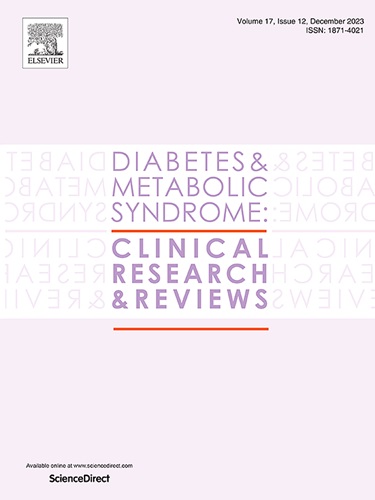Evaluating the causal effect of using glucagon-like peptide-1 receptor agonists on the risk of autoimmune diseases
IF 3.4
Q1 ENDOCRINOLOGY & METABOLISM
Diabetes & Metabolic Syndrome-Clinical Research & Reviews
Pub Date : 2025-01-01
DOI:10.1016/j.dsx.2025.103186
引用次数: 0
Abstract
Objective
To investigate the causal association of using glucagon-like peptide-1 receptor (GLP1R) agonists with autoimmune diseases.
Methods
The available cis-eQTLs for drugs target genes (GLP1R) were used as genetic variants for exposure to GLP1R agonists. Type 2 diabetes was used as positive control. Mendelian randomizations (MR) were performed to explore the association of genetically-proxied GLP1R agonists with 11 autoimmune diseases from large-scale consortia. Replicating the findings in the FinnGen study and then pooled with meta-analysis. Finally, we performed MR analysis to examine whether GLP1R agonists affect 731 immune cell phenotypes to clarify the potential mechanism.
Results
We observed supportive evidence to support the association of GLP1R agonists with reduced the risk of hypothyroidism (OR [95 %] = 0.89 [0.82–0.95], P < 0.001), but increased risk of ulcerative colitis (OR [95 %] = 1.48 [1.27–1.71], P < 0.001), type 1 diabetes (OR [95 %] = 1.34 [1.21–1.50], P < 0.001), systemic lupus erythematosus (OR [95 %] = 1.61 [1.29–2.02], P < 0.001) and sarcoidosis (OR [95 %] = 1.38 [1.08–1.75], P = 0.008). There was no supporting evidence to verify the association of GLP1R expression with asthma, Crohn's disease, multiple sclerosis and myasthenia gravis (P > 0.05). In addition, we found that GLP1R agonists was positively associated with 221 immune cell phenotypes (P < 0.05, OR > 1), and negatively associated with 317 immune cell phenotypes (P < 0.05, OR < 1).
Conclusion
GLP1R agonists are causally associated with various autoimmune diseases potentially through the modulation of 731 immune cell phenotypes.
评估使用胰高血糖素样肽-1受体激动剂对自身免疫性疾病风险的因果影响。
目的:探讨胰高血糖素样肽-1受体(GLP1R)激动剂与自身免疫性疾病的因果关系。方法:利用现有的药物靶基因(GLP1R)顺式等位基因作为GLP1R激动剂暴露的遗传变异。2型糖尿病作为阳性对照。采用孟德尔随机化(MR)来探索遗传代理的GLP1R激动剂与来自大规模财团的11种自身免疫性疾病的关系。复制FinnGen的研究结果,然后进行荟萃分析。最后,我们进行了MR分析,以检查GLP1R激动剂是否影响731种免疫细胞表型,以阐明其潜在机制。结果:我们观察到支持GLP1R激动剂与降低甲状腺功能减退风险相关的支持性证据(OR [95%] = 0.89 [0.82-0.95], P 0.05)。此外,我们发现GLP1R激动剂与221种免疫细胞表型呈正相关(p1),与317种免疫细胞表型负相关(P)。结论:GLP1R激动剂可能通过调节731种免疫细胞表型与多种自身免疫性疾病有因果关系。
本文章由计算机程序翻译,如有差异,请以英文原文为准。
求助全文
约1分钟内获得全文
求助全文
来源期刊

Diabetes & Metabolic Syndrome-Clinical Research & Reviews
ENDOCRINOLOGY & METABOLISM-
CiteScore
22.90
自引率
2.00%
发文量
248
审稿时长
51 days
期刊介绍:
Diabetes and Metabolic Syndrome: Clinical Research and Reviews is the official journal of DiabetesIndia. It aims to provide a global platform for healthcare professionals, diabetes educators, and other stakeholders to submit their research on diabetes care.
Types of Publications:
Diabetes and Metabolic Syndrome: Clinical Research and Reviews publishes peer-reviewed original articles, reviews, short communications, case reports, letters to the Editor, and expert comments. Reviews and mini-reviews are particularly welcomed for areas within endocrinology undergoing rapid changes.
 求助内容:
求助内容: 应助结果提醒方式:
应助结果提醒方式:


